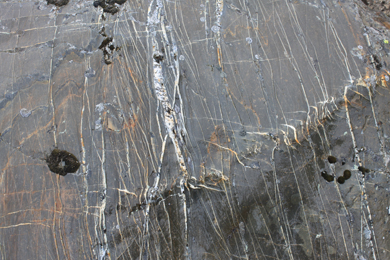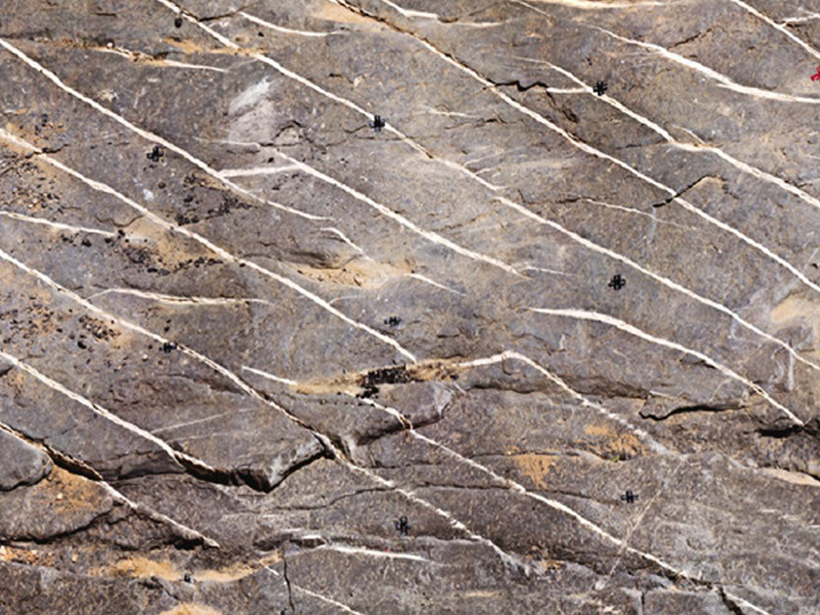Understanding how fractures develop in rocks has been a challenging area of research in the Earth sciences for more than a hundred years. While we have learned much about the spatial and temporal complexity of subsurface rock fractures, significant challenges remain. A recent article in Reviews of Geophysics describes how future advances will require new approaches based on a chemical perspective. Here, one of the authors answers some questions about the role of chemical processes in fracture development and what new insights they can bring.
Which mechanical and geochemical processes create fractures in rock?

The origin of fractures found in rocks in the Earth is traditionally viewed as a problem of mechanics. Rocks tend to have low tensile strength so, in principle, fractures can form easily.
Some of the processes that cause natural fractures include regional deformation of the crust caused by plate tectonics, localized folding and faulting, pore pressure changes including those caused by hydrocarbon maturation, and uplift and unroofing as topography develops.
However, new evidence suggests that chemical reactions within rocks have a profound influence on the development of natural fracture systems.
For fractures formed at depths of about 1 to 10 kilometers and temperatures of 50 to 200℃, chemical reactions are more common and more diverse than previously recognized.
Rocks at depth fracture in the presence of hot, reactive fluids such as water and gas and these conditions create the potential for corrosion, cement precipitation, and other chemically dependent processes.
Why do we need to better understand and predict fracture patterns in rock?
The Earth’s subsurface plays a vital role in contemporary society. It is home to natural resources such as groundwater, hydrocarbons, and geothermal energy. It contains spaces, or “reservoirs”, for the sequestration of carbon dioxide, wastewater, and nuclear waste. And seismic activity—both natural and induced—occurs in the subsurface zone.
Accurate and testable predictions of fracture patterns in rock are essential for effective management of subsurface engineering operations.
Since fractures affect directions, magnitudes, and heterogeneities of both fluid flow and rock strength, they significantly influence all of these.
Thus, accurate and testable predictions of fracture patterns in rock are essential for effective management of subsurface engineering operations. Furthermore, understanding pre-existing natural fractures is key to anticipating and controlling engineered fractures.
What are some of the challenges of measuring and modeling subsurface fracture patterns?
Fracture patterns remain stubbornly indistinct and unpredictable despite more than a century of progress.
Fracture patterns remain stubbornly indistinct and unpredictable despite more than a century of progress in a number of important areas including detection, sophisticated mechanics-based and statistical modeling approaches, and expensive drilling and well-testing campaigns in the private and public sector.
Our review of the challenges reveals that severe limitations remain despite renewed efforts on research drilling. Fracture data are difficult to acquire and interpret and, in fact, some key attributes of subsurface fractures, such as length distributions, cannot be acquired with current technology.
Better predictive models—both numerical and outcrop-based—are needed, but they need to be able to be validated. Meanwhile, validation has been a particularly large hurdle because essential information for comparing predictions with natural examples has been hard to acquire. An example is the determination of when fractures formed, or fracture age.
What insights do chemical processes offer into fracture formation and evolution?

A chemical perspective can overcome some of the challenges of understanding subsurface fractures as mentioned above, partly because the byproducts of chemical processes make fractures more complex and thus, paradoxically, easier to interpret.
We can use chemical analysis, experimentation, modeling and theory to better understand how fracture patterns develop at different geological time scales.
For example, chemical insights allow us to better interpret and use limited subsurface samples and to select and interpret outcrop analogs that otherwise provide ambiguous or misleading information about the subsurface.
Chemical evidence also provides guidance for determining which predictive models are correct. Recent work shows that chemical processes affect how fracture patterns develop. These processes need to be incorporated into future models aimed at predicting subsurface fracture attributes.
Our review describes some recent and quite surprising discoveries based on using chemical evidence to unravel the timing and rates of fracture formation.
Can you give an example of a particular discovery based on adopting a chemical perspective?
Conventional expert opinion holds that natural fractures form rapidly, perhaps nearly instantaneously, in response to major Earth events such as plate collisions, mountain building, and fault movement.
While this is probably the case for some fractures, actually measuring rates and timing has been beyond the reach scientists. This hampers building models that can predict fractures in inaccessible subsurface locations.
A study conducted on fractures from East Texas showed that in this area, where no specific structural ‘event’ is known (it is a relatively tectonically quiescent area) some fractures gradually and steadily grew for almost 50 million years. The probable cause is pore pressure increases caused by natural gas generation. This type of study has been repeated elsewhere, revealing the timing and causes of real fractures in various geologic settings, where previously the causes of fractures were inferred from models.
What are some of the unresolved questions where additional research, data or modeling is needed?

Our review was co-authored by a large group of researchers, and each member from each sub-discipline has their own unresolved questions.
The systematic description has only just begun of chemical effects in fractures in rocks within sedimentary basins that have reached temperatures in the range of 50 to 200 °C.
The chemical effects on pattern development and network connectivity need to be systematically investigated in natural examples from the subsurface and from suitable outcrops.
A campaign of experimental rock mechanics testing under reactive conditions is also needed.
In addition, we need new models that build on insights from the laboratory and from nature, and that extend coupled modeling approaches to geological time scales. Furthermore, theoretical studies are needed to explore the processes that recent fracture studies reveal at relevant time and length scales.
With new integrative mechanical and chemical models on the horizon, the community is on the cusp of finding solutions to what has been one of the most challenging practical problems in subsurface science.
An array of powerful chemical concepts and analytical tools will undoubtedly help improve understanding of fracture patterns in the Earth. An increased emphasis on the role of chemistry in how fracture patterns evolve leads to insights not otherwise obtainable. Exploration of this realm of natural chemical experiments over geologic timescales could yield more accurate predictions of subsurface fluid pathways and more reliable subsurface engineering. With new integrative mechanical and chemical models on the horizon, the community is on the cusp of finding solutions to what has been one of the most challenging practical problems in subsurface science.
—Stephen E. Laubach ([email protected]; ![]() 0000-0003-2511-9414), University of Texas at Austin, USA
0000-0003-2511-9414), University of Texas at Austin, USA
Citation:
Laubach, S. E. (2019), How chemical processes influence fracture pattern development, Eos, 100, https://doi.org/10.1029/2019EO136309. Published on 14 November 2019.
Text © 2019. The authors. CC BY-NC-ND 3.0
Except where otherwise noted, images are subject to copyright. Any reuse without express permission from the copyright owner is prohibited.

